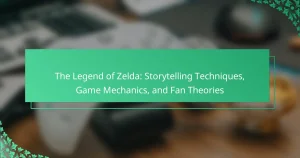Sonic the Hedgehog captivates gamers with its fast-paced gameplay and iconic blue character. This article explores Sonic’s distinctive features, innovative mechanics, and significant cultural impact. It highlights memorable levels, the franchise’s evolution across platforms, and the challenges faced in maintaining relevance. Sonic’s enduring legacy continues to influence the gaming landscape and popular culture.

What are the defining characteristics of Sonic the Hedgehog?
Sonic the Hedgehog is defined by his speed, distinctive blue color, and attitude. He features agile gameplay mechanics, allowing for fast-paced platforming and exploration. Sonic’s cultural impact includes becoming a gaming icon and starring in various media. His unique ability to curl into a ball while running and collect rings distinguishes him from other characters.
How does Sonic’s design influence player perception?
Sonic’s design significantly influences player perception by embodying speed, agility, and a vibrant personality. His iconic blue color and spiky appearance create an immediate visual impact, symbolizing energy and motion. Players associate Sonic with fast-paced gameplay, leading to expectations of quick reflexes and dynamic levels. Additionally, his cheerful demeanor and adventurous spirit foster a sense of connection, enhancing player engagement. This combination of visual and character attributes solidifies Sonic’s status as a beloved gaming icon.
What role do colors and branding play in Sonic’s identity?
Colors and branding are crucial in defining Sonic’s identity. The vibrant blue color of Sonic symbolizes speed and energy, making him instantly recognizable. This distinct hue differentiates him from other characters, reinforcing his unique attribute. Additionally, the branding strategy emphasizes a playful and adventurous spirit, appealing to a broad audience. Sonic’s logo and design elements consistently reflect these themes, contributing to his lasting cultural impact.

What gameplay mechanics set Sonic the Hedgehog apart from other platformers?
Sonic the Hedgehog distinguishes itself from other platformers through its emphasis on speed, momentum, and unique level design. The gameplay mechanics focus on fast-paced movement, allowing players to navigate levels quickly while collecting rings and defeating enemies. Sonic’s spin dash and homing attack provide dynamic combat options, enhancing player engagement. Additionally, the incorporation of loop-de-loops and ramps creates a distinctive flow, setting it apart from traditional platforming experiences. The game’s cultural impact is significant, with Sonic becoming an iconic character and a symbol of the gaming industry.
How does the speed mechanic enhance the gaming experience?
The speed mechanic significantly enhances the gaming experience in Sonic the Hedgehog by creating a sense of exhilaration and urgency. Players navigate through vibrant levels at high velocities, which fosters engagement and excitement. This mechanic encourages quick reflexes and strategic thinking, as players must react swiftly to obstacles and enemies. Additionally, the speed promotes exploration, allowing players to uncover hidden areas and collect items, enriching gameplay. Overall, the speed mechanic is a defining feature that shapes player interactions and contributes to Sonic’s cultural impact in gaming.
What unique abilities does Sonic possess compared to his rivals?
Sonic possesses unique abilities that set him apart from rivals, including super speed, agility, and the Spin Dash attack. His super speed allows him to outrun enemies and obstacles, while his agility enables quick maneuvers. The Spin Dash attack provides an offensive option to defeat foes and break through barriers. Additionally, Sonic’s ability to collect rings grants him extra protection and enhances his resilience in gameplay. These traits contribute to his iconic status in gaming culture.
![]()
Which iconic levels and environments are featured in Sonic games?
Sonic games feature iconic levels and environments such as Green Hill Zone, Chemical Plant Zone, and City Escape. These settings combine vibrant visuals, unique gameplay mechanics, and memorable music, contributing to Sonic’s cultural impact. Green Hill Zone is renowned for its lush greenery and rolling hills, while Chemical Plant Zone introduces complex platforming challenges. City Escape showcases urban landscapes and thrilling chase sequences, highlighting Sonic’s speed and agility. Each environment enhances the overall gaming experience, making them unforgettable in the franchise.
How do level designs reflect Sonic’s fast-paced gameplay?
Level designs in Sonic the Hedgehog enhance fast-paced gameplay by prioritizing speed, fluid movement, and quick reflexes. The environments feature loops, ramps, and slopes that facilitate rapid acceleration and momentum. Each level is crafted with multiple pathways, encouraging exploration while maintaining a sense of urgency. The design elements promote seamless transitions between sections, ensuring players remain engaged in high-speed action. Sonic’s unique ability to dash through obstacles is complemented by these dynamic layouts, reinforcing the game’s core attribute of speed.
What are the most memorable zones across the Sonic franchise?
The most memorable zones across the Sonic franchise include Green Hill Zone, Chemical Plant Zone, and City Escape. These zones are iconic for their unique designs and gameplay mechanics.
Green Hill Zone is recognized for its vibrant visuals and classic loop-de-loops. Chemical Plant Zone features challenging platforming and hazardous obstacles, making it a fan favorite. City Escape combines urban settings with dynamic gameplay, highlighted by the memorable truck chase sequence.
Other notable zones include Sky Sanctuary Zone, known for its serene atmosphere and unique enemies, and Green Hill Zone’s remakes in various Sonic titles, which showcase its lasting impact. Each zone contributes to Sonic’s cultural significance and legacy in gaming.

How has Sonic the Hedgehog evolved across different gaming platforms?
Sonic the Hedgehog has evolved significantly across various gaming platforms, adapting gameplay mechanics and features. Initially launched on the Sega Genesis, Sonic introduced fast-paced platforming and vibrant graphics. As technology advanced, Sonic transitioned to 3D environments on consoles like the Dreamcast, enhancing gameplay with new mechanics, such as homing attacks and spin dashes.
With each platform iteration, Sonic’s cultural impact grew, becoming a symbol of speed and agility in gaming. The franchise expanded to include mobile games, allowing for on-the-go play while maintaining core attributes like speed and character design. Rare attributes, such as unique power-ups and character abilities, emerged in different titles, keeping the gameplay fresh and engaging.
Sonic’s adaptability across platforms illustrates its enduring appeal, demonstrating how a character can evolve while retaining its iconic essence. The franchise continues to influence new generations of gamers, showcasing the balance between innovation and nostalgia.
What adaptations have been made for mobile gaming?
Mobile gaming adaptations for Sonic the Hedgehog include streamlined controls, optimized graphics, and enhanced performance. These changes improve accessibility and gameplay experience on smaller screens. Unique features like touch controls and adaptive difficulty cater to diverse player preferences. Additionally, multiplayer options and social connectivity enrich engagement within the mobile platform.
How do PC and console versions differ in gameplay experience?
PC and console versions of Sonic the Hedgehog differ significantly in gameplay experience. The PC version typically offers higher graphical fidelity and customizable controls, while consoles provide a more standardized experience with optimized performance.
PC players can access mods that enhance gameplay, introduce new levels, or alter character abilities, providing a unique twist. In contrast, console versions focus on a consistent user interface and streamlined gameplay, often emphasizing multiplayer capabilities.
Additionally, the loading times on PC can be shorter due to superior hardware, whereas consoles may have longer load durations but offer seamless integration with online services. Each platform’s community also shapes the gameplay experience, influencing player engagement and competition.

What impact has Sonic the Hedgehog had on popular culture?
Sonic the Hedgehog has significantly influenced popular culture through its memorable characters, gameplay, and media adaptations. The franchise introduced iconic elements like speed-based gameplay and vibrant worlds, which set a standard for platformers. Sonic’s character, embodying rebellion and attitude, resonated with audiences, shaping the identity of video game mascots. The series expanded into animated shows, comics, and movies, further embedding Sonic in global culture. Notably, the franchise’s music, particularly the catchy theme songs, has left a lasting impression, inspiring generations of fans and artists.
How is Sonic represented in media beyond video games?
Sonic the Hedgehog is represented in various media beyond video games, including animated series, films, and comics. The character’s design, speed, and adventurous spirit are central themes across these formats.
Animated adaptations like “The Adventures of Sonic the Hedgehog” and “Sonic Boom” showcase his personality and relationships with other characters. The 2020 film “Sonic the Hedgehog” emphasizes his unique abilities and the battle against Dr. Robotnik, broadening his appeal to a wider audience.
Comics, particularly those published by Archie Comics and IDW Publishing, explore Sonic’s universe in greater depth, featuring intricate storylines and character development. These adaptations reinforce Sonic’s cultural impact, making him a recognizable and beloved figure across generations.
What influence has Sonic had on other video game franchises?
Sonic the Hedgehog has significantly influenced other video game franchises through its innovative gameplay mechanics and cultural impact. The introduction of high-speed platforming inspired titles like Super Mario and Rayman. Sonic’s emphasis on character design and personality led to the creation of memorable mascots across the industry. Additionally, the franchise’s focus on vibrant worlds and engaging storylines has encouraged narrative depth in games like Crash Bandicoot and Spyro the Dragon. Sonic’s unique blend of speed and style set a standard for action games, shaping the evolution of the platforming genre.

What are the community’s perceptions and fan contributions to Sonic?
The community perceives Sonic the Hedgehog as a beloved icon, with fans contributing through art, fan games, and discussions. Many appreciate its fast-paced gameplay and nostalgic elements. Sonic’s cultural impact is evident in various media adaptations, merchandise, and fan events. Unique fan contributions often highlight personal experiences with the franchise, showcasing its lasting influence.
How do fan-made games and mods enhance Sonic’s legacy?
Fan-made games and mods significantly enhance Sonic’s legacy by fostering creativity and community engagement. These projects allow fans to explore unique gameplay mechanics and reinterpret iconic features, which keeps the franchise vibrant. By introducing new levels, characters, and stories, fan creations expand the Sonic universe, attracting both old and new players. Furthermore, they often preserve the nostalgic elements while integrating modern gaming trends, ensuring Sonic remains relevant in an evolving gaming landscape.
What role do fan conventions play in Sonic’s community?
Fan conventions play a crucial role in Sonic’s community by fostering connection among fans. These events provide opportunities for networking, sharing creative works, and celebrating the franchise’s legacy. Attendees often engage in discussions about gameplay mechanics and iconic features, enhancing their understanding and appreciation of Sonic. Unique merchandise and fan art are commonly showcased, highlighting the community’s creativity. Additionally, conventions often feature panels with game developers, offering insights into Sonic’s cultural impact and future developments in the franchise.

What challenges has Sonic faced in maintaining relevance?
Sonic has faced challenges in maintaining relevance due to evolving gaming trends and competition. As technology advanced, Sonic struggled to adapt, leading to inconsistent game quality. The franchise’s identity became diluted with various spin-offs that did not resonate with fans. Additionally, the rise of 3D gaming introduced new gameplay mechanics, which Sonic’s traditional platforming style struggled to keep up with. Despite these challenges, Sonic remains a cultural icon, leveraging nostalgia and recent successful adaptations to regain traction.
How have trends in gaming affected Sonic’s popularity?
Trends in gaming have revitalized Sonic’s popularity by appealing to nostalgia while introducing modern gameplay mechanics. The rise of indie games has inspired new Sonic titles, emphasizing speed and platforming. Enhanced graphics and storytelling have attracted a younger audience. Collaborations with popular franchises have expanded Sonic’s reach, solidifying his status in gaming culture.
What lessons can be learned from Sonic’s ups and downs in the industry?
Sonic’s journey in the gaming industry teaches valuable lessons about innovation and adaptability. The franchise’s initial success stemmed from its unique speed-based gameplay and character design, appealing to a broad audience. However, subsequent missteps, such as inconsistent game quality and failed adaptations, highlight the importance of maintaining brand integrity. Emphasizing fan engagement and feedback can lead to revitalization, as seen in Sonic’s recent successful titles. Ultimately, balancing nostalgia with innovation is crucial for longevity in the competitive gaming landscape.
What are best practices for engaging with Sonic’s evolving fanbase?
Engaging with Sonic’s evolving fanbase involves embracing community feedback and fostering interactive experiences. Prioritize transparency in communication to build trust. Utilize social media platforms to share updates and solicit fan input. Host events that celebrate Sonic’s legacy while introducing new content, ensuring inclusivity for both long-time fans and newcomers. Collaborate with fan creators to enhance engagement and generate fresh ideas.


